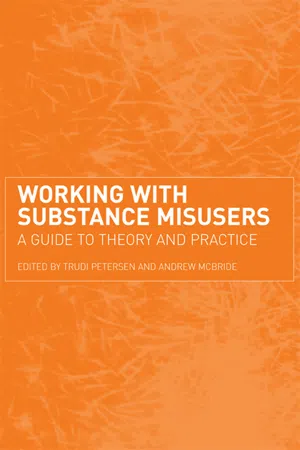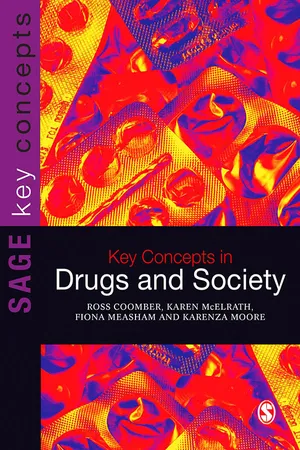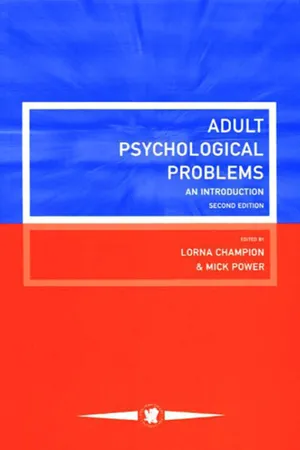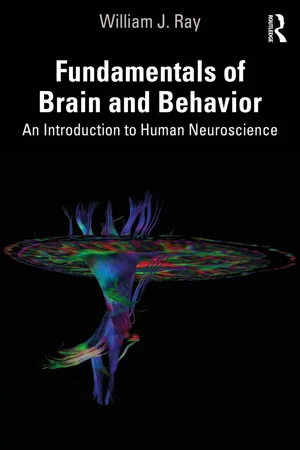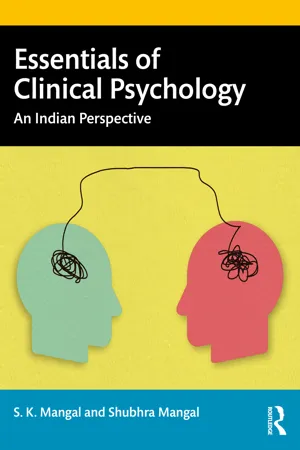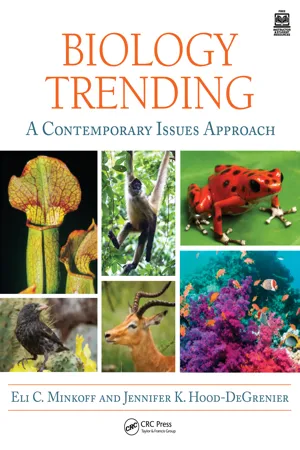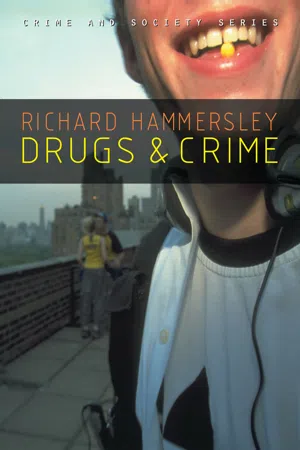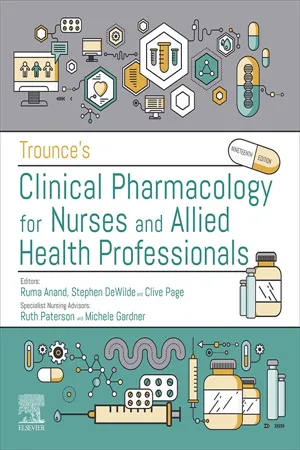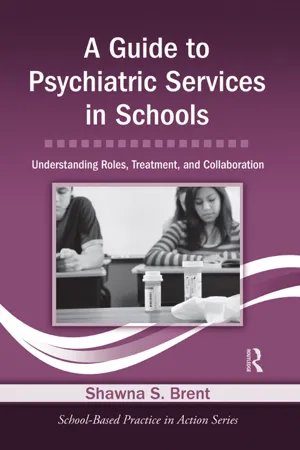Psychology
Types of Psychoactive Drugs
Psychoactive drugs can be categorized into four main types: depressants, stimulants, hallucinogens, and opioids. Depressants, like alcohol and benzodiazepines, slow down the central nervous system. Stimulants, such as cocaine and amphetamines, increase brain activity. Hallucinogens, like LSD and psilocybin, alter perception and mood. Opioids, including heroin and prescription painkillers, relieve pain and produce a sense of euphoria.
Written by Perlego with AI-assistance
11 Key excerpts on "Types of Psychoactive Drugs"
Learn about this page
Index pages curate the most relevant extracts from our library of academic textbooks. They’ve been created using an in-house natural language model (NLM), each adding context and meaning to key research topics.
- eBook - ePub
Working with Substance Misusers
A Guide to Theory and Practice
- Trudi Petersen, Trudi Petersen(Authors)
- 2005(Publication Date)
- Routledge(Publisher)
Part I The Basics
Passage contains an image
Chapter 1 Some Drugs of Misuse
Andrew McBride DOI: 10.4324/9780203995365-1Learning ObjectivesAfter you have studied this chapter you will understand the basic effects and ill effects of some of the more commonly used substances in the UK.Introduction
The drugs described in this chapter, and throughout most of this book, act specifically on the brain and central nervous system and therefore on the mind. They commonly also have effects on many other parts of the body. Drugs not usually considered to be ‘psychoactive’ (mind altering) also commonly have effects on the metabolism of the brain, and in some circumstances cause psychological effects. There are almost no limits to the drug effects that some people will seek out for pleasure (for example, high doses of aspirin) but only commonly used psychoactive drugs will be considered here.The number of existing and designable potent psychoactive drugs runs to more than a thousand, and the effects at a chemical and cellular level are incomprehensibly complex for all but the specialist neuro-psycho-pharmacologist. Fortunately, for most practical purposes the psychoactive drugs that people take for pleasure can be classified much more simply, by their effects.A Simple Classification Of Psychoactive Drugs
The simplest such classification might categorise drugs by their most obvious effect into:- Stimulants; that wake you up, speed you up and give you energy. This group includes amphetamine and cocaine.
- Depressants; that make you calm, drowsy or put you to sleep. This group includes opioids, benzodiazepines, volatile substances and cannabis.
- Hallucinogens; that change your perception of the world, by distorting what you see and hear, or make you experience things that aren't there at all. This group includes LSD and Magic Mushrooms.
- eBook - ePub
- Ross Coomber, Karen McElrath, Fiona Measham, Karenza Moore(Authors)
- 2013(Publication Date)
- SAGE Publications Ltd(Publisher)
non-medical use of drugs, criminalising the possession and trafficking (supply, intent to supply, import/export, production) of controlled drugs. These drugs are classified into classes A-C in accordance with perceived levels of harm, and schedules 1–5 in accordance with ease of access. Other jurisdictions have similar classification systems. Recently these classifications have been subject to dispute (Nutt et al., 2010), raising concerns about the relative arbitrariness of such supposedly ‘objective’ measures of harm which form the basis for legal classification of ‘drugs’.PHYSICAL/PSYCHOACTIVE DEFINITIONS OF DRUGS
Second, in terms of defining drugs by their attributed physical or psychoactive effects, there are four broad pharmacological categories of drugs:- Stimulants (‘uppers’) are drugs that speed up the central nervous system, make the user feel more alert and energetic, causing people to stay awake for long periods of time, decrease appetite and make the user feel euphoric. For example, cocaine, amphetamines, nicotine, caffeine.
- Depressants (‘downers’) are drugs that slow down the functions of the central nervous system and make the user less aware of the events around them. For example, alcohol, opiates (painkillers, for example, opium, morphine, heroin, codeine, methadone, Demerol, Percodan), sedatives/hypnotics (for example, barbiturates, such as Seconal, sleeping medications, tranquilisers such as Valium, Librium and diazepam).
- Hallucinogens (psychedelics) are drugs that distort the senses and one’s awareness or perception of people and events, possibly resulting in hallucinations (seeing or hearing things that do not exist). For example, LSD, PCP (angel dust), mescaline (buttons), psilocin (contained in ‘magic’ mushrooms).
- Deliriants
- eBook - ePub
Adult Psychological Problems
An Introduction
- Lorna Champion, Michael Power(Authors)
- 2014(Publication Date)
- Taylor & Francis(Publisher)
There is a vast range of psychoactive drugs which can be used to excess, some illicit but many legal. The effects they produce vary, and the consequences of heavy sustained use differ, depending partly on the particular drug and partly on personal characteristics of the drug user. Some people, for example, become intoxicated with much smaller amounts of alcohol than others, and this is influenced by their sex, their body mass, their recent daily intake of alcohol, and so on. Likewise, the likelihood that someone will turn to crime to finance their drug use will be affected by factors such as opportunities for legal employment and their personal moral code. Drugs can nevertheless be classified according to the psychoactive effects which they produce through their action on the central nervous system (the CNS, which includes the brain), and one such classification system is described in the following section.GENERAL CLASSES OF PSYCHOACTIVE DRUGS
The Royal College of Psychiatrists (1987) has listed five main categories of psychoactive drugs which are frequently misused: opiates, depressants, stimulants, hallucinogens, and minor tranquillisers. Examples of drugs falling into each category, with details of their main effects are as follows.The opiates
These include natural extracts from the opium poppy (e.g. morphine, codeine), drugs derived from these via some chemical modification (e.g. heroin), and a range of synthetic compounds which have similar chemical structures (e.g. methadone, dihydrocodeine). Opiates are medically prescribed for pain relief, but also tend to produce pleasant mood states, and in some cases a transient euphoric “high” or “rush”, which occurs shortly after drug ingestion. They are capable of inducing tolerance and physical dependence, and the withdrawal syndrome includes severe ‘flu-like symptoms such as sweating, shaking, weakness, runny eyes and nose, aching, and nausea. As yet no permanent medical consequences have been directly associated with opiate use, though, as discussed later, lack of care in the way the drugs are used may lead indirectly to numerous health hazards. - eBook - ePub
Essential guide to the Psychedelic Renaissance
All you need to know about how psilocybin, MDMA and LSD are revolutionizing mental health and changing lives
- Antón Gómez-Escolar(Author)
- 2022(Publication Date)
- ArgoNowta(Publisher)
I NTRODUCTION TO P SYCHOACTIVE S UBSTANCESP SYCHOACTIVE… DRUGS?In the previous chapter, we saw that psychoactive substances are those that, upon entering the body (via any route: oral, nasal, intramuscular, intravenous), exert a direct effect on the central nervous system, causing specific changes to its functions (pain, state of mood, perceptions, etc.). Examples of these substances may include: alcohol, caffeine, anxiolytics, antidepressants, painkillers...and other psychoactive drugs, including some of the illicit kind.When we speak of illicit psychoactive drugs we are referring, of course, to those whose production, trafficking or sale has been illegalized. If we were to ask about them on the street, the first thing people would comment on would be their addictive, harmful and, in certain circumstances, even deadly nature. Yet, these characteristics are not intrinsic to these substances, but rather depend to a large extent on the use that is made of them.So, when talking about psychoactve substances: if they are not all illegal, not all addictive, not all harmful, what do they have in common? What identifies them as a family and differentiates them from all other drugs or any other existing substance?As we began to see in the previous chapter, it all comes down to where they act and what effects they produce.What all the molecules mentioned above have in common is their ability to directly influence neuronal activity in the central nervous system. Psychoactive substances act on the neuroreceptors of these neurons (or on the neurotransmitters that allow them to communicate with each other), resulting in psychoactive effects of various kinds, like modifying our consciousness, mood, level of alertness, etc. Drugs, whether legal, restricted for medical use, or illegalized1 - eBook - ePub
Fundamentals of Brain and Behavior
An Introduction to Human Neuroscience
- William J. Ray(Author)
- 2024(Publication Date)
- Routledge(Publisher)
Siegel, 2001 ). Thus, someone can experience an overdose by first developing tolerance to a drug in a familiar situation. This tolerance may be associated with an increase in the amount of the drug to counter the effects of tolerance. However, if the person uses the same amount of the drug in a novel situation, an overdose can be experienced. The result is that the overdose is more associated with the external and internal cues of the situation than the actual amount of the drug used. Thus, to be effective, drug treatments need to consider both the external and internal cues associated with the use of the drug by extinguishing these associations.Thought Question: What are three specific takeaways from this feature that help you understand drug addiction and its treatment better?Concept Check
- Throughout our evolutionary history, humans have ingested psychoactive substances. Give a brief timeline of what we know about that history including dates, locations, and substances.
- What can we say about the use of both legal and illegal psychoactive substances in the US?
- What can animal studies tell us about the power of psychoactive substances on the individual?
- What are the steps in the pattern of addiction, and what drives the process from one step to the next?
- There is no one answer to what causes addiction, but what are three important factors that should be considered?
- How can drugs change your brain? What is the role of dopamine in the effect of psychoactive substances?
Major Psychoactive Substances
Traditionally, psychoactive substances are discussed in terms of their effects on the central nervous system. Three broad categories are depressants, stimulants, and hallucinogens. Depressants such as alcohol and barbiturates reduce the activity of the central nervous system. This reduction of activity can be seen overall as when a person falls asleep after drinking alcohol or more localized as when reduction in frontal lobe activity reduces the inhibitions experienced by the person. Stimulants, on the other hand, increase the activity of the central nervous system. Common stimulants include amphetamines, caffeine, nicotine, cocaine, and opiates such as morphine. The class of psychoactive drugs that has the most influence on the central nervous system is hallucinogens (Schartner, Carhart-Harris, Barrett, Seth, & Muthukumaraswamy, 2017 - eBook - ePub
Essentials of Clinical Psychology
An Indian Perspective
- S. K. Mangal, Shubhra Mangal(Authors)
- 2023(Publication Date)
- Routledge(Publisher)
In looking into the list of disorders classified as substance-related addictive disorders, given earlier, we see that each of these disorders is related to the abuse of one or the other types of psychoactive substances. Depending upon the nature of their effects, these psychoactive substances may, then, be classified as (A) Depressants or Sedatives, (B) Stimulants, and (C) Deliriant or mind-blowing drugs. Let us know about them.A. Depressants or Sedatives
The substances included in this category are termed depressants or sedatives on account of their characteristics of exercising an inhibiting effect on one’s central nervous system that results in diminishing the responses of the brain and nervous system and slowing down the individual’s activities. As a result, these are used to relieve anxiety, stress or pain, as well as induce sleep. However, their abuse turns into a variety of problems, including one or the other types of substance-related addictive disorders. Among the psychoactive substances included in this category, alcohol is the most consumed and abused substance all over the globe. The others include the drugs classified as Opioids and Sedative-Hypnotic drugs.- Alcohol: More specifically termed ethyl alcohol or ethanol, alcohol is a psychoactive substance that is produced by the fermentation of sugars, usually in agricultural products such as fruits, cereals, and vegetables, with or without subsequent distillation. As a depressant it has an inhibiting effect on one’s central nervous system, allowing the individual to relax in moments of tension and stress. It is this relaxed feeling that draws an individual to take alcoholic beverages. However, on account of the intoxicating effects, one is forced to take more and more doses for experiencing the same pleasure-giving effect, and is thus caught in the vicious cycle of falling victim to the ill consequences of alcohol abuse. The ill consequences of alcohol abuse result in the following types of impairment and damage:
- In terms of physiological damage, almost every tissue and organ of the body and its functioning is adversely affected by alcohol abuse, including the immune system of the body, making one an easy victim of diseases.
- In terms of psychological and behavioral functioning damage, alcohol abuse may cause: (i) severe deterioration in the thought processes and damage to intellectual functioning, to the extent of leading an individual to “black out” causing an inability to remember what he said or did, (ii) a quite significant deterioration in motor coordination, balance, speech, sensation and perception, (iii) deterioration in sex behavior in the form of sexual incapacity or impotence, and indulgence in sexual deviations and sex crimes, (iii) severe personality or character disorders to the extent of terming one a criminal and antisocial personality, (iv) making one victim of a number of neurological and psychotic disorders (brain syndromes) such as pathological intoxication, delirium tremens, alcoholic hallucinosis, alcoholic deterioration, and Korsakoff syndrome.
- eBook - ePub
- Erich Goode(Author)
- 2022(Publication Date)
- Routledge(Publisher)
Psychoactive substances are chemicals that influence how the brain works—and consequently, how we think, feel, and act. In common-day parlance, we refer to such substances as “drugs.” They activate an “out of the ordinary” state of mind that induces atypical behavior and make a great deal of routine behavior more difficult. At a sufficiently large dosage, we call this condition “intoxication,” and the process of achieving it, “getting high.” With some drugs, again, at the requisite dosage, most people experience a feeling of relaxation, but with certain other drugs, users become less controlled, more impulsive, and less capable of adequately performing their day-to-day jobs, attending to family obligations, keeping appointments, and studying and learning, in short—they fall short at acting as functioning, conventional members of mainstream society. Certain drugs, the stimulants, intensify concentration; the person under the influence can perform a given task even more effectively and efficiently than normally. Humans also use drugs as medication, of course. But a number of such substances, when taken at larger than therapeutic dosages, are psychoactive. And at even larger doses, they cause serious bodily harm, even death. It’s our goal in this chapter to reach an understanding of what’s deviant—and what’s not deviant—regarding the consumption of psychoactive chemicals. Presumably, the effects of some of these drugs have convinced the members of societies around the globe to condemn their use and legislators to control—in a number of cases, to criminalize—the possession and sale of certain psychoactive substances. In other words, in virtually all countries around the world, formal social control, including arrest and incarceration, enter the deviance picture and influence behavior in multiple social contexts.As we saw, vastly more people use legal drugs (alcohol and tobacco) than illegal drugs; alcohol is decidedly psychoactive, and even tobacco produces a “low-key high.” The consumption of psychoactive substances is mainly - eBook - ePub
Biology Trending
A Contemporary Issues Approach
- Eli Minkoff, Jennifer K. Hood-DeGrenier(Authors)
- 2023(Publication Date)
- CRC Press(Publisher)
Cellular tolerance results from changes in the receptors for the drug, principally the receptors on the nerve cells in the brain. Tolerance results from either a drug-induced decrease in the number of receptors or an increase in the threshold needed to trigger a response. Heroin produces these changes in the brain within a week or two of daily use. Some drugs can cause permanent damage to receptors and, therefore, tolerance to these drugs becomes permanent. For most drugs, however, tolerance is not permanent but disappears gradually with time. The time period varies greatly from one drug to another.So far, we have emphasized the effects of psychoactive drugs on the brain. However, these drugs also have effects throughout the body, as we see in the next section.THOUGHT QUESTIONS- If a person has never learned to feel pleasure or satisfaction from daily activities, will they be more attracted to the artificial pleasure offered by drugs? Can this suggest anything to us about drug prevention strategies? One slogan says that “Hugs are better than drugs.” Does this slogan correlate with neurobiological findings? Can this idea be applied in drug prevention programs?
- Because psychoactive drugs work directly on the brain cells, are individuals exempted from responsibility for their own drug use? (Can a drug user justify their behavior by saying “the drug made me do it”?) Apply this reasoning to alcohol and tobacco as well as illegal drugs.
13.4 DRUG ABUSE IMPAIRS HEALTH
In addition to addiction, the use of psychoactive drugs can impair the health of individual drug users in other ways. It can also affect their gametes, and thus the development of their children.13.4.1 Drug effects on the health of users
Drug abuse negatively affects the health of individuals and society. In the United States, deaths from drug overdoses rose steadily from under 20,000 in 1999 to over 70,000 in 2017. In recent years, the vast majority of these overdose deaths have been caused by synthetic narcotics, especially fentanyl, which is 50–100 times more potent than morphine, from which heroin is derived. While synthetic and natural opioids (including heroin) are responsible for the majority of drug overdoses (about 68% in 2017), other drugs, including cocaine, methamphetamines, tranquilizers (e.g., Valium and Xanax), and alcohol, also cause significant numbers of overdose deaths. In addition, many more deaths result from health conditions caused by chronic drug use. - eBook - ePub
Drugs and Crime
Theories and Practices
- Richard Hammersley(Author)
- 2015(Publication Date)
- Polity(Publisher)
2What Are Drugs?
Even more than crime, drugs form a topic where all sources of information are biased. Official sources tend to take a pessimistic view, emphasizing problems and addiction, and hypothesizing that biological factors are primary. For example, the National Institute on Drug Abuse (2006) defined addiction as follows:Drug addiction is a complex brain disease. It is characterized by drug craving, seeking, and use that can persist even in the face of extremely negative consequences. Drug-seeking may become compulsive in large part as a result of the effects of prolonged drug use on brain functioning and, thus, on behavior. For many people, relapses are possible even after long periods of abstinence.Many writers in the academic literature are dubious about the usefulness of the disease model of addiction (see further reading), and at minimum not only the drug but also the mindset of the user and the setting of use are important (Zinberg, 1984).Definitions
The collective noun ‘drugs’ is often used as if it referred to something clear and concrete. It doesn’t. Imprecise thinking about ‘drugs’ is hardly extraordinary in everyday life, but it is surprising in supposedly educated and informed writing about drug problems. In everyday life ‘drugs’ has two meanings. The most relevant one roughly means ‘substances that have some sort of psychological effect that make people want to take them and are illegal to take in this way’. But many experts would include alcohol and tobacco at least with other drugs, although they are legal to take in many countries, at least by adults under defined conditions. Others see the legal status of substances as irrelevant to scientific definitions and prefer to classify all substances that have some sort of psychological effect that make people want to take them as ‘drugs’, whether they are illegal or not. This should incorporate many ‘drugs’ not in widespread use (see Dalgarno and Shewan, 2005) and probably many natural and synthetic pharmaceuticals that have not yet been used as ‘drugs’. For such reasons some people prefer to refer to ‘chemicals’, as in ‘chemical dependence’, or ‘substances’ instead of drugs. Both these terms seem to me unable to capture the special issues of ‘drugs’. ‘Chemicals’ is problematic for the consumption of plants and other materials where we are unsure about the biochemistry. It is also problematic because it is feasible that some ‘chemical dependencies’ involve only placebo effects, sugar being one example (Reid and Hammersley, 1999), so many chemicals are not ‘drugs’ and some ‘drugs’ are not chemicals (even if they are made of chemicals like everything else). ‘Substances’ is really too wide and potentially includes any food, drink, cosmetic or other substance ingested which might directly or indirectly have psychological effects. If face cream makes users feel happy, is this a ‘mood-altering substance’? Does it matter if it really penetrates the skin or not? A final reason for sticking with ‘drugs’ is that the legal status of substances can have major effects on use. If heroin were legal, inexpensive and freely available without prescription, then different people would use it, in different ways, and different problems would result. It might not be considered a ‘drug’. Alcohol use in Saudi Arabia is not the same behaviour as alcohol use in the UK. At the time of writing, in most of Europe, North America, Australia and New Zealand, tobacco is moving towards being a ‘drug’, having not been classified as such for some eighty years, while cannabis is gravitating in the other direction, towards not being a drug, like alcohol. It is becoming good practice to ask about cannabis separately in surveys and interviews, as young people in the UK (and reportedly in the USA) who use cannabis sometimes believe that they do not take drugs, only ‘blow’. - Clive P. Page, Ruma Anand, Stephen DeWilde(Authors)
- 2021(Publication Date)
- Elsevier(Publisher)
Many drugs have been produced in the hope that they would have some therapeutic effect. Certain mental illnesses, particularly depression and schizophrenia, are linked with chemical abnormalities in the brain. The nature of some of these abnormalities is known, but there are considerable gaps in our knowledge. Nevertheless, the knowledge gleaned so far from medical research has resulted in the introduction of drugs that are designed to target brain mechanisms that may alleviate some of the symptoms of mental illnesses. This chapter describes the different drugs used in various psychiatric disorders. Types of Mental Illness The treatment of psychiatric disorders can be considered in terms of three main types of disorders: psychosis, anxiety and depression (although there are other types of mental disorders discussed later). Psychosis is a term used to describe disorders when the patient loses contact with reality. Features of psychosis may include hallucinations (perceptual disturbance), delusions (false fixed beliefs), altered behaviour, speech and thought disturbance. Anxiety is a term often used to describe a condition of excessive worry or fear. It is featured by an emotionally inappropriate response to the patient’s environment and to circumstances. Traditionally, patients were termed ‘neurotic’ but this term is no longer favoured. Commonly used professional terms to describe the symptoms of anxiety include social phobia, agoraphobia, panic disorder, generalized anxiety disorder, etc. Anxiety and depression can often coexist. Depression is a term used for several disorders that are characterized by changes in mood, thoughts and behaviour. Professionals describe depression as an affective disorder. Symptoms can range from extreme sadness to suicidal intent- eBook - ePub
A Guide to Psychiatric Services in Schools
Understanding Roles, Treatment, and Collaboration
- Shawna S. Brent(Author)
- 2012(Publication Date)
- Routledge(Publisher)
Four
Psychopharmacology
GENERAL PRINCIPLES OF PSYCHOPHARMACOLOGY
Over the past three decades, there has been a rapid transformation in the field of psychiatric medicine. Psychiatrists had previously been very involved in psychological theory, and understanding a person’s unconscious was the preferred method of intervention. The 1990s were termed the decade of the brain, and extensive research about how the brain works occurred. This allowed for the design of additional interventions. Biological theories now exist in more detail to explain many psychological problems. There has been significant advancement in the understanding of the brain, which has resulted in improved identification of mental illness and in different treatment options.One of the advancements in biological understanding of mental illness has been the arrival of new medications. Numerous medications have been developed over the past 15 years. There have been new classes of medications designed that are more beneficial in part because of increased tolerability and increased ease of administration. Medications have been identified to treat mood disorders, anxiety disorders, behavioral disorders, psychotic disorders, autistic disorders, and eating disorders. Medications are also useful in treating target symptoms such as agitation, aggression, irritability, and sleep disturbance. Each of these medications can have a role in improving a youth’s functioning. It is important to remember that these medications may not change the underlying disease process and clearly will not change the stressor that may have initiated the problem. However, benefit can occur when the intensity of the distress begins to lessen. Many physicians are of the view that medication can reduce some symptom intensity, which allows psychotherapeutic interventions to work more successfully.
